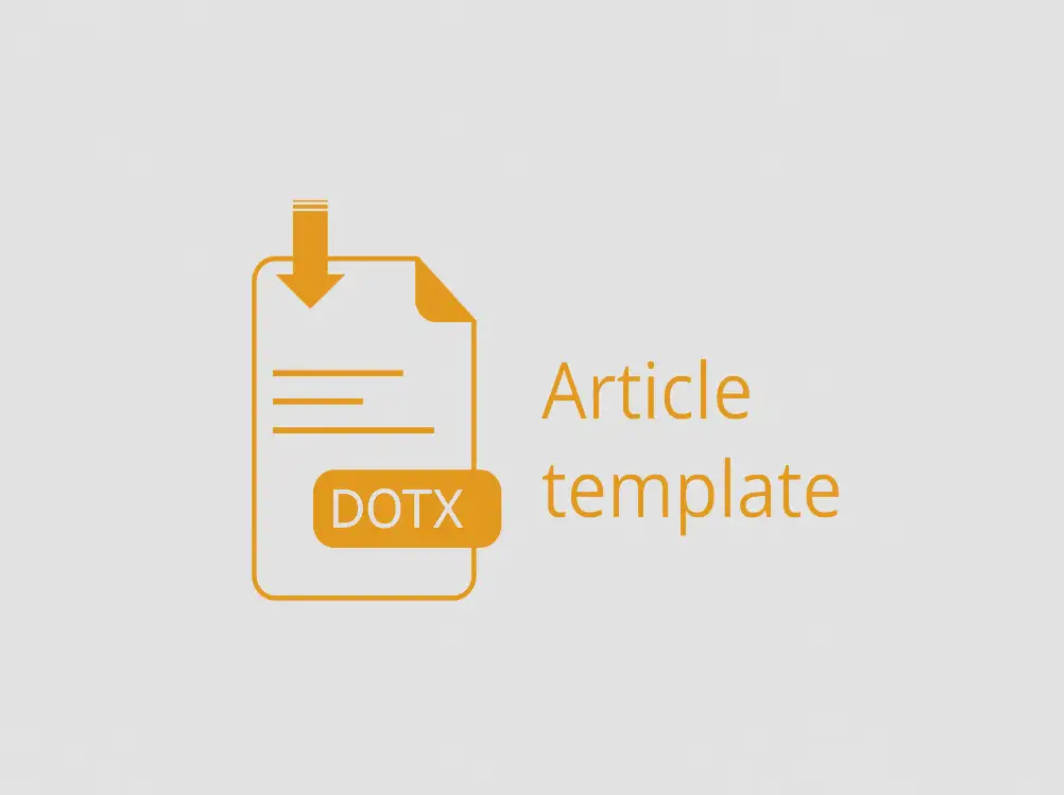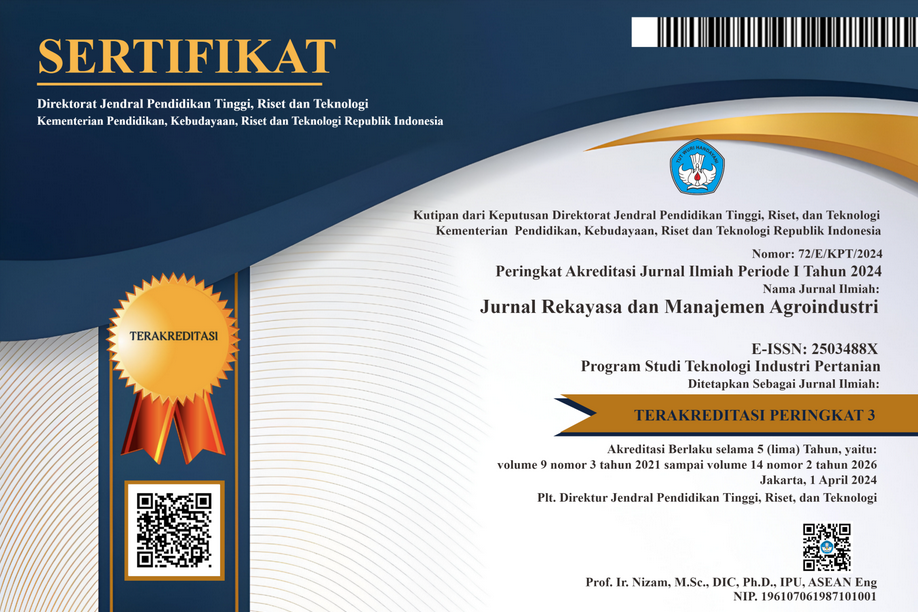Pengaruh Jenis Pelarut dan Ukuran Partikel pada Ekstraksi Kulit Buah Kakao (Theobroma cacao L.) menggunakan Metode Microwave Assisted Extraction (MAE) terhadap Karakteristik Ekstrak
Abstract
This research was conducted to determine the effect of the type of solvent and particle size on the extraction of cocoa pods using the Microwave Assisted Extraction (MAE) method on the characteristics of the extract as a source of antioxidants and to determine the type of solvent and particle size in the extraction of cocoa pods using Microwave Assisted Extraction (MAE) precise in obtaining the highest antioxidant capacity extract. The experimental design used in this study was a factorial randomized block design which was grouped into 2 groups based on the implementation time and consisted of two factors. The first factor is the type of solvent which consists of 3 levels, namely methanol, ethanol and acetone. The second factor is particle size which consists of 3 levels, namely 40 mesh, 60 mesh and 80 mesh. The data were analyzed by analysis of variance and continued with Tukey test. The results showed that the type of solvent and particle size had a very significant effect on the yield, total phenolic, total flavonoid and antioxidant capacity. The interaction between treatments had a very significant effect on total flavonoids and antioxidant capacity, and had a significant effect on total phenolics, but had no significant effect on the yield of cocoa pod peel powder extract. The best treatment to produce cocoa pod peel extract on extraction using MAE was ethanol solvent and particle size 80 mesh with yield characteristics of 12.23±0.61% total phenolic 148.84±0.10 mg GAE/g extract, total flavonoids of 94.16±0.23 mgQE/g extract, and antioxidant capacity of 133.30±0.49 mg GAEAC/g extract.
Keywords : Solvent type, particle size, antioxidants, cocoa pod husk
Downloads
References
Anggreni, N.M.D., G.P.G. Putra dan L.P. Wrasiati. 2019. Karakteristik ekstrak kulit buah kakao (Theobroma cacao L.) sebagai sumber antioksidan pada perlakuan jenis pelarut. Jurnal Mahasiswa Universitas Udayana. 8(2): 28-37.
Antari, O., N.M. Wartini dan S. Mulyani. 2015. Pengaruh ukuran partikel dan lama waktu ekstraksi terhadap karakteristik ekstrak warna alami buah pandan. Jurnal Rekayasa dan Manajemen Agroindustri. 3(4):488-503.
Badan Pusat Statistik. 2019. Statistik kakao Indonesia 2018. Badan Pusat Statistik Indonesia, Jakarta
Campos-Vega, R., K.H. Nieto-Figueroa dan B.D. Oomah. 2018. Cocoa (Theobroma cacao L.) pod husk: renewable source of bioactive compounds. Trends in Food Science & Technology. 81(1):172-184.
De Garmo, E. P., W. G. Sullivan, and C. R. Canada. 1984. Engineering Economy. Macmillan Publisher, New York.
Departemen Kesehatan RI, 1995, Farmakope Indonesia Edisi IV, 551, 713. Jakarta.
Handayani, H., Sriherfyna, F. H., dan Yunianta, Y. 2015. Ekstraksi antioksidan daun sirsak metode ultrasonic bath (kajian rasio bahan: pelarut dan lama ekstraksi). Jurnal Pangan dan Agroindustri, 4(1): 262-272.
Harborne, J. B. 1987. Metode Fitokimia: Penuntun Cara Modern Menganalisis Tumbuhan. Institut Teknologi Bandung, Bandung.
Hernani dan Raharjo, M. 2005. Tanaman Berkhasiat Antioksidan. Penebar Swadaya, Jakarta.
Harsini., T., dan Susilowati. 2010. Pemanfaatan kulit buah kakao dari limbah perkebunan kakao sebagai bahan baku pulp dengan proses organosolv. Jurnal Ilmiah Teknik Lingkungan 2(2) :80-89.
Hutomo, G.S., D.W. Marseno dan S. Anggrahini. 2012. Synthesis and characterization of sodium carboxymethylcellulose from pod husk of cacao (Theobroma cacao L.). African Journal of Food Science. 6(6):180-185.
Jain, T., Jain, V., Pandey, R., Vyas, A., and Shukla, S. S. 2009. Microwave assisted extraction for phytoconstituents–an overview. Asian Journal of Research in Chemistry. 2(1): 19-25.
Kemit, N., I W.R. Widarta dan K.A. Nocianitri. 2015. Pengaruh jenis pelarut dan waktu maserasi terhadap kandungan senyawa flavonoid dan aktivitas antioksidan ekstrak daun alpukat (Persea Americana Mill). E. Jurnal Itepa Universitas Udayana. (1): 130-141
Langat, M. K. 2011. Microwave assisted extraction - an innovative and promising extraction tool for medicinal plant research. Pharmacognosy Reviews. 1 (1):7-18.
Makanjuola, S. A. 2017. Influences of particle size and extraction solvent on antioxidant properties of extracts of tea, ginger, and tea-ginger blend. Food Science and Nutrition 5(1):1179- 1185.
Momuat L.I, Suryanto E, Rantung O, Korua A. dan Datu H. 2015. Perbandingan senyawa fenolik dan aktivitas antioksidan antara sagu baruk segar dan sagu baruk kering. Chemistry Progress. 8(1), 20-29.
Norra, I dan A. Abdullah. 2016. Effects ofdrying methods, solvent extraction and particle size of malaysian brown seaweed, Sargassum sp. on the total phenolic and free radical scavenging activity. International Food Research Journal 23(4):1558-1563.
Norliza, A.W., S. Rozita dan M.C. Board. 2006. Volatile flavour and fragrance components analysis in fermented cocoa pod husks (CPH). Malaysian International Cocoa Conference 4. Malaysian Cocoa Board.
Nuraini dan M.E., Mahata. 2009. Pemanfaatan Kulit Buah Kakao Fermentasi Sebagai Pakan Alternatif Ternak Di Daerah Sentra Kakao Padang Pariaman. Universitas Andalas, Padang
Pratyaksa, I.P.L., G.P. Ganda Putra dan L. Suhendra. 2020. Karakteristik ekstrak kulit buah kakao (Theobroma cacao L.) sebagai sumber antioksidan pada perlakuan ukuran partikel dan waktu maserasi. Jurnal Rekayasa dan Manajemen Agroindustri. 8(1):139-149
Rifai, G., I.W.R. Widarta dan K.A. Nocianitri. 2018. Pengaruh jenis pelarut dan rasio bahan dengan pelarut terhadap kandungan senyawa fenolik dan aktivitas antioksidan ekstrak biji alpukat (Persea americana Mill.). Jurnal ITEPA. 7(2):22-32.
Santana, N.B., J.C.T. Dias, R.P. Rezende, M. Franco, L.K.S. Oliveira dan L.O. Souza. 2018. Production of xylitol and bio-detoxification of cocoa pod husk hemicellulose hydrolysate by Candida boidinii XM02G. Plos one. 13(4):195-206.
Santos, R.X., D.A. Oliveira, G.A. Sodré, G. Gosmann, M. Brendel dan C. Pungartnik. 2014. Antimicrobial activity of fermented Theobroma cacao pod husk extract. Genetics and Molecular Research. 13(3):7725-7735.
Sartini, R., M. Asri dan Ismail. 2017. Pengaruh pra perlakuan sebelum pengeringan sinar matahari dari kulit buah kakao terhadap kadar komponen fenolik dalam extrack. Jurnal Biologi Makassar, 2(1):15-20.
Sembiring, B., B. Ma’mun dan E. I. Ginting. 2008. Pengaruh kehalusan bahan dan lama ekstraksi terhadap mutu ekstrak temulawak. Bul Littro 17(2):53-58.
Septiana, A. T, dan A. Asnani. 2009. Kajian ekstraksi rumput laut coklat Sargassum sp sebagai penghambat oksidasi LDL dan akumulasi kolesterol makrofag. Laporan Penelitian Universitas Jendral Soedirman. Purwokerto
Sudarmadji, S., B. Haryono dan Suhardi. 2007. Analisis Bahan Makanan Dan Pertanian. Liberty, Yogyakarta.
Susanto, F.X. 1994. Tanaman Kakao Budidaya dan Pengolahan Hasil. Kanisius, Yogyakarta.
Taroreh, M., S. Raharjo, P. Hastuti dan A. Murdiati. 2015. Ekstraksi daun gedi (Abelmoschus manihot L.) secara sekuensial dan aktivitas antioksidannya. Agritech. 35(3):280-287.
Utami, R. R., S. Supriyato., S. Rahardji., R. Armunanto. 2017. Aktivitas antioksidan kulit biji kako dari hasil penyangraian biji kakao kering pada derajat ringan, sedang dan berat. Jurnal Agritech. 37(1): 88-94.
Verdiana, M., I W. R. Widarta, dan I D. G. M. Permana. 2018. Pengaruh jenis pelarut pada ekstraksi menggunakan gelombang ultrasonik terhadap aktivitas antioksidan ekstrak kulit buah lemon (Citrus limon (Linn.) Burm F.). Jurnal Ilmu dan Teknologi Pangan. 7(4):213-222.
Wawo, B. 2008. Mengolah Limbah Kulit Buah Kakaomenjadi Bahan Pakan Ternak. Penyuluh Pertanian Madya, Yogyakarta.
Widarta, I.W.R. dan I.W. Arnata. 2017. Extraction of bioactive compounds from avocado leaves by sonication at various solvent types and concentration. Agritech Journal 37(2):158-166.
Wilson, I. D. et al, 2000, Encyclopedia of New York Separation Science, Academic-Press,132
Yapo, B.M. dan K.L. Koffi. 2013. Extraction and characterization of gelling and emulsifying pectin fractions from cocoa pod husk. Journal of Food and Nutrition Research. (4):46-51.

Ciptaan disebarluaskan di bawah Lisensi Creative Commons Atribusi-BerbagiSerupa 4.0 Internasional.
Seluruh artikel di Jurnal ini dapat disebarluaskan atas tetap mencantumkan sumber yang syah. Identitas judul artikel tidak boleh dihilangkan. Penerbit tidak bertangggung jawab terhadap naskah yang dipublikasikan. Isi artikel menjadi tanggung jawab Penulis.














